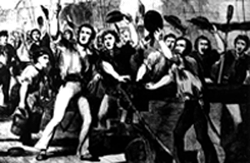
 |
 |

| Getting Started Key Words & Concepts Glossary Activities Recommended Resources Scuttlebutt | ||||
Getting Started  To fight battles, Constitution needed more than agility and speed. She needed to be armed. If there is an historic site displaying cannon in your area, perhaps your students are familiar with this type of weapon. Tell them that cannon, also called guns or long guns, were used at sea, as well as on land. Considering the weight of these massive armaments, students might wonder why ships didn’t sink. Part of the answer can be found in this lesson. | ||||
Key Words and Concepts
Before examining the cannon itself, ask students what a cannon shoots. Do they know what the round shot, or cannon ball, weighs? You might have students handle objects in the classroom that approximate the weight of a cannon ball to help them understand just how heavy these balls are. Explain to the class that the cannon balls on Constitution were three different sizes, weighing 12, 18, and 24 pounds. (Hand out the worksheet Sink or Sail? and provide students with the following information to fill in the first row of blanks in the table.) The guns themselves were named after the size of the shot they fired. Thus a gun that fired 24-pound balls was called a 24-pounder.
 Tell students that the gun itself weighed roughly 230 pounds per pound of ball. Have them compute the weights of the different caliber, or size, guns and enter the numbers on their tables. Then ask the class to compute the total weight of all the cannon on Constitution. Ask students what piece of information is missing in order to make this calculation? They will need to know how many of each caliber gun Constitution had. She started out with 30 24-pounders, 16 18-pounders, and 14 12-pounders. Have them enter these numbers in their tables and multiply by the weight per gun to get the total pounds of each caliber gun. To find the weight of all cannon on board, they must add the three totals together.
Tell students that the gun itself weighed roughly 230 pounds per pound of ball. Have them compute the weights of the different caliber, or size, guns and enter the numbers on their tables. Then ask the class to compute the total weight of all the cannon on Constitution. Ask students what piece of information is missing in order to make this calculation? They will need to know how many of each caliber gun Constitution had. She started out with 30 24-pounders, 16 18-pounders, and 14 12-pounders. Have them enter these numbers in their tables and multiply by the weight per gun to get the total pounds of each caliber gun. To find the weight of all cannon on board, they must add the three totals together.
How many cannon of all sizes did Constitution have? She was designed to carry a minimum of 44 guns and she carried 60. Now have students convert their grand total of pounds to tons (2,000 pounds per ton). Tell students that Constitution settled one inch in the water for each 10 tons of weight aboard her. This is called her immersion factor. How many inches did she settle from the weight of her big guns? (About 13 1/2 inches, a far cry from sinking!)
 |
Ballou's Pictorial Drawing-Room Companion. Circa 1850 USS Constitution Museum, Boston |
How far do students think they could hurl objects that approximate the weight of a cannon ball? A 24-pounder could send its shot a forceful 1,200 yards. To give students a notion of this distance, you might have them measure how far they can throw a baseball. The distance from home plate to first base, for example, is 30 yards. How did these big guns send their heavy shot such impressive distances? By a chemical reaction from the burning of gun powder inside the cannon. Ignited powder produces a gas which expands almost instantaneously to 300 times the volume, or space, of the powder.
The rapid expansion of gas creates the pressure that hurled the shot out the barrel of the cannon. Students may wonder why the pressure did not blow up the gun itself. Explain that the guns were extremely strong, because they were cast of solid iron, then bored out. The distance the shot traveled depended in part on the amount of powder used. There were three sizes of powder cartridge for close-, moderate- and long-range shooting.
To damage enemy ships, what besides a single ball could be fired from the guns? There were many kinds of shot, including small grape shot wrapped and tied together and chain shot, a split ball connected by a chain made to damage rigging and masts. None of these exploded on impact. They tore holes by pummeling and splintering. Sailors feared the flying splinters of wood more than the shot itself, because these fragments wounded and maimed far more men.
Besides the guns, how else was Constitution armed? When enemy ships came together, crews engaged in hand-to-hand combat using muskets, pistols and cutlasses. Other weapons included pikes, or spears, and blunderbusses, which were muskets with flared muzzles that scattered its shot. Fortunately for Constitution, she was never host to any of these enemy boarding parties.
- cannon: a heavy firearm mounted on wheels
- immersion factor: a measure of how much a ship settles in the water
- cartridge: a container for gun powder
- grape shot: a cluster of small iron balls shot from cannon
- cutlass: a sword with a straight or slightly curved blade
- boarding parties: sailors appointed to make an attack on an enemy ship by storming aboard
| K-4
5-8
9-12
|
 |